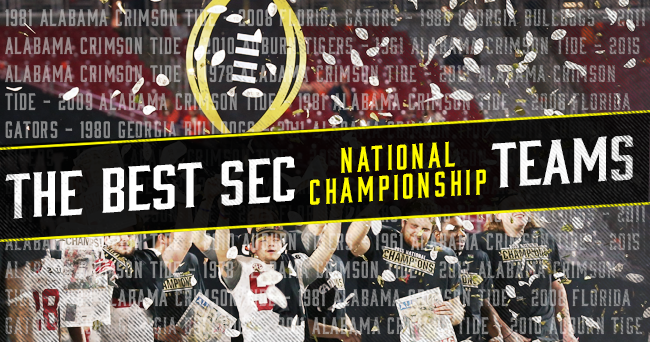
Ranking Top 10 SEC national champions: No. 10
The SEC claims it has won at least 40 college football national championships. The exact number is debatable — primarily depending on Alabama’s oft-discussed total, which just grew by one to 16 (or something close to it). The NCAA puts the SEC’s total at 28.
Whether 28, 40 or somewhere in between, what’s even more debatable is determining the 10 greatest national champions in SEC history.
We tried anyway.
There are many ways to measure greatness, and just about every measure makes more sense than this one, which somehow produced a Top 100 of all time list that didn’t include a single SEC team in the top 25.
It doesn’t make sense to compare eras, so we didn’t. Bear Bryant’s defensive linemen weren’t as big as some of Nick Saban’s linebackers. Steve Spurrier’s quarterbacks threw more passes in 12 quarters than Joe Namath did in 10 games. Instead, we created three eras (before 1970, 1971-1992 and 1993-present), allowing the opportunity to recognize the best team in the first two while bowing to progress and acknowledging they couldn’t compete with a modern day Derrick Henry.
Undefeated champions are nice, but not a prerequisite because not all schedules are created equal. Coaching greatness mattered because the best typically find a way. Onside kick, anyone? So do the best players.
With those parameters in mind, we begin our countdown of the 10 greatest NCAA champions in college football history.
No. 10: 1961 Alabama
Record: 11-0
PPG: 26.09
Allowed: 2.27
SRS: 24.03. SRS combines margin of victory and strength of schedule, where 0 is average. The higher the number, the more dominant the team. The 1961 team’s SRS was higher than Alabama’s 2015 and 2009 championship teams.
Statistical oddity: In 10 regular season games, Tommy Brooker led Alabama with 12 catches and Richard Williamson led Alabama with 203 receiving yards. In 2014, Amari Cooper exceeded both totals — against Auburn in the Iron Bowl.
Names to know: QB Pat Trammell passed for 1,035 yards, then a school record. Lee Roy Jordan, an All-American, anchored the defense.
Their case for greatness: For decades after, this was the defense by which all others were measured — not just at Alabama, but across college football — the one that delivered Bear Bryant his first national championship at Alabama.
Bryant’s Tide allowed 25 points — in 11 games. The Tide intercepted 19 passes — or almost one for every 11 attempts. It took N.C. State’s Roman Gabriel –a four-time NFL Pro Bowler — to score a rushing touchdown against them.
Gabriel’s touchdown came in the fourth game, and it was the last touchdown the Tide allowed.
Alabama closed the regular season with five consecutive shutouts before allowing a lone field goal in a 10-3 Sugar Bowl victory over Arkansas to complete an 11-0 season.
“In 1961 we had the best team in college football. Not the biggest, but the best,” Bryant recalled in his autobiography, as quoted in rollbamaroll.com. “We certainly weren’t very big, and we got a lot of attention for that over the next few years. We did not deliberately go out looking for smaller players in those days, but we demanded quickness and it usually came in smaller packages. Bigness is in the heart, anyways.”
Other Tide defenses have dominated, but the 1961 squad set the bar for the 1992, 2009, 2011 and 2015 defenses to hurdle.
“It’s two different times, so it’s hard to compare them with the other teams,” former Tide All-American defensive back Bobby Johns told al.com in a piece comparing Alabama’s greatest defenses of all time shortly after the 2011 Tide team blanked LSU to win the national championship. “But they looked awfully good. They’re more physical than when I played and, holy cow, they’re so big. It’s amazing how big and fast they are. And you’ve got to give it to Coach Saban. He can coach some ball.”
Bill Wieseman, an offensive lineman on the 1961 championship team, summed up the comparison as well as anyone could:
“One thing is the size that they have compared to us,” he told al.com. “We didn’t have anybody playing as big as them that can move like they do. Most of our kids were little. I was considered a lard-butt at 210. It’s the same football, but two different eras. We were good in our day, and they’re excellent in their day.”
